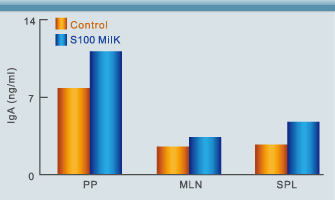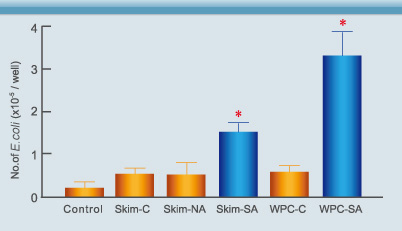
HOME > Research
Nghiên cứu lâm sàng
Animal Study I(6):
Nghiên cứu trên động vật I (6):
Kobayashi et al. (1991) fed two groups of animal subjects with either ordinary skim milk (control group) or S100 Milk (treatment group). After seven days’ feeding, the animal subjects were exposed to high doses of X-rays. The animals continued to be fed with ordinary skim milk or S100 Milk until the study concluded. It was found that animal subjects fed with S100 Milk clearly had a higher survival rate than the control group (Fig. 2).
Measurements of IgA production by GALT (Peyer’s patches, mesenteric lymph node) and spleen showed higher levels in the treatment group compared to the control group. In addition, the number of lactobacteria (good bacteria) in the intestinal tract was also shown to increase in the S100 Milk group (Fig. 3).
Kobayashi (1991) thực hiện thí nghiệm trên hai nhóm động vật, một nhóm sử dụng sữa bột tách kem bình thường (nhóm đối chứng), nhóm còn lại sử dụng sữa bột S100 (nhóm can thiệp). Sau 7 ngày, chiếu X- quang sau đó lại tiếp tục quá trình thí nghiệm, phát hiện ra nhóm động vật sử dụng sữa S100 có tỷ lệ sống cao hơn nhóm đối chiếu (Hình 2). Đo lượng IgA trong các mô lympho đường ruột (tấm Peyper, hạch bạch huyết mạc treo), lá lách phát hiện lượng IgA ở nhóm can thiệp cao hơn nhóm đối chứng. Ngoài ra số lượng lợi khuẩn trong đường ruột cũng tăng ở nhóm S100 (Hình 3).

Fig. 2. Survival Rates of animal subjects after X-rays irradiation shows that survival of treatment group animals was significantly higher than the control group(6).
Hình 2 Tỷ lệ sống của nhóm can thiệp sau khi chiếu tia X cao hơn nhóm đối chứng (6).

Fig. 3. Measurements of IgA production by Peyer’s patch (PP), mesenteric lymph node (MLN) and spleen (SPL) cells showed that animals fed S100 Milk produced higher levels of IgA compared to the control group(6).
Hình 3 Lượng IgA có trong tấm Peyer, hạch bạch huyết mạc treo (MLN), lá lách của nhóm sử dụng S100 nhiều hơn ở nhóm đối chứng (6).
Animal Study II(7):
Thí nghiệm trên động vật II (7):
In order to evaluate the potential effects of immune milk products containing specific antibody on the intestinal microflora of cancer patients undergoing chemotherapy treatments, Nomoto et al. (1992) developed an immune milk containing specific antibody against a strain of E. coli commonly found in the mouse GI. Animal subjects were fed either commercial skim milk (Skim-C), commercial WPC (WPC-C) or skim milk containing natural antibodies (Skim-NA) separately as control groups. Separate groups of animals were also fed with whey protein concentrate (WPC) with specific antibody against the mouse strain of E. coli or skim milk with the same specific antibody against the mouse strain of E. coli as the two treatment groups.
After seven days’ feeding, researchers injected the mice with the anti-cancer drug 5-flurouracil (5-FU), inducing side effects similar to what would be expected in similarly treated human subjects (5-FU can cause the number of E. coli in the intestinal tract to increase, resulting in overgrowth and infection). Specific antibodies in the immune milk were shown to effectively prevent E. coli overgrowth in the intestinal tract (Fig. 4 and Table 1). The authors concluded that if patients undergoing long-term chemotherapy were to consume milk containing specific antibodies, the risk of internal infection by E. coli and other bacteria would be effectively reduced or even prevented(7).
Để đánh giá hiệu quả của thành phần kháng thể có trong sữa S100 đối với các vi khuẩn trong đường ruột của bệnh nhân đang thực hiện hóa trị.
Nomoto (1992) tiến hành thí nghiệm trên chuột GI, chia làm hai nhóm, một nhóm sử dụng sữa bột bình thường (Skim –C), WPC –C, nhóm còn lại sử dụng sữa có kháng thể tự nhiên (Skim-NA). Sau 7 ngày sử dụng, chuột GI được tiêm thuốc 5-FU chống ung thư như các bệnh nhân ung thư được tiêm trong thời gian trị bệnh (lượng vi khuẩn E.coli gia tăng dẫn đến hiện tượng viêm nhiễm). Các kháng thể đặc biệt trong sữa miễn dịch cho thấy có khả năng ngăn ngừa vi khuẩn E.coli trong đường ruột phát triển một cách hiệu quả.
Kháng thể đặc biệt có trong sữa miễn dịch có hiệu quả ngăn cản sự phát triển của vi khuẩn E.coli trong đường tiêu hóa (Hình 4, bảng 1). Dựa vào kết quả thí nghiệm, Nomoto kết luận bệnh nhân tiếp nhận hóa trị liệu có thể ngăn ngừa hoặc giảm nguy cơ nhiễm vi khuẩn E.coli và các vi khuẩn khác nhờ sử dụng sữa miễn dịch có chứa thành phần kháng thể đặc biệt.

Fig. 4. Shown are the numbers of E. coli phagocytized by macrophages. The treatment groups showed higher levels of phagocytosis than the control groups(7). * p<0.01 Skim-C: Control group (commercial skim milk); Skim-NA: Control group (commercial skim milk containing natural antibody); Skim-SA: treatment group (skim milk containing specific antibody); WPC-C: Control group (commercial WPC); WPC-SA: treatment group (WPC containing specific antibody).
Hình 4. Số lượng vi khuẩn E-coli bị đại thực bào thực bào. Mức độ thực bào ở nhóm can thiệp nhiều hơn ở nhóm đối chứng (7) * p<0.01
Skim-C: Nhóm đối chứng (sữa bột gầy bình thường); Skim-NA: Nhóm đối chứng (sữa bột gầy có chứa kháng thể tự nhiên); Skim-SA: Nhóm can thiệp (sữa bột gầy có kháng thể đặc biệt); WPC-C: Nhóm đối chứng (sữa WPC bình thường); WPC-SA: Nhóm can thiệp (WPC có chứa kháng thể đặc biệt)
| Days before or after administration of 5-FU | Log10 no.of E.coli in cecum | |||
| Exp | No treatment | Skim-C | Skim-NA | Skim-SA |
| –7 | 3.51±0.74 | 3.51±0.74 | NT | 3.51±0.74 |
| –1 | 3.68±0.57 | 3.34±0.55 | NT | 3.85±0.81 |
| +1 | 8.19±0.57 | 8.00±0.57 | NT | 6.71±1.88** |
| +3 | 8.09±0.24 | NT | NT | 6.39±1.04* |
| +7 | 8.72±0.11 | NT | NT | 8.38±0.28* |
| + 10 | 8.08±0.23 | NT | NT | 8.01±0.27 |
Table 1. E. coli counts in the cecum at times before or after administration of 5-FU. The number of E. coli in the treatment group was significantly lower than the control group(7). NT, not tested. * p < 0.01 and ** p = 0.06
Bảng 1. Những ngày trước và sau khi tiêm thuốc 5-FU. Lượng vi khuẩn E-coli ở nhóm can thiệp ít hơn nhóm đối chứng (7). NT, not tested-Không kiểm tra
* p<0.01 and ** p=0.06
Animal Study Ⅲ(8):
In a study to determine the effects of S100 Milk on aging, Ishida et al. (1992) fed animal subjects with either ordinary skim milk (control group) or S100 Milk (treatment group). After six months’ and after sixteen months’ feeding, animal subjects fed with S100 Milk showed reduced numbers of Enterobacteriaceae in the large intestine and in the cecum (Fig. 5).
In addition, lower serum antibody levels against enteric bacteria suggested that the groups fed S100 Milk had lower levels of invasive bacteria translocating from the intestinal tract into the bloodstream(8) (Fig. 6).

Fig. 5. Determination of the number of enterobacteria in the small intestine, large intestine and cecum, showed that the treatment group had a significantly lower levels than the control group(8). * p<0.01
Hình 5. Lượng vi khuẩn họ enterobacteria trong ruột non, ruột già, cecum ở nhóm can thiệp ít hơn nhóm đối chứng8). * p<0.01

Fig. 6. Measurements of serum antibodies levels against intestinal bacteria show that the treatment group had lower levels than the control group indicating a lower rate of translocation into the bloodstream(8). * p<0.05, ** p<0.01
Hình 6. Lượng kháng thể trong huyết thanh chống lại các vi khuẩn đường ruột ở nhóm can thiệp thấp hơn nhóm đối chứng chứng tỏ một tỷ lệ nhỏ các kháng thể di chuyển vào huyết thanh (8).* p<0.05, ** p<0.01
From the studies above, we can conclude that S100 Milk may reduce the risk of intestinal infection for cancer patients undergoing chemotherapy and/or radiation therapy and for people whose immune system is declining due to aging.
Từ kết quả của các nghiên cứu trên, chúng ta kết luận rằng sữa S100 có thể giúp bệnh nhân ung thư giảm nguy cơ nhiễm trùng đường ruột khi đang điều trị hóa học và xạ trị, những bệnh nhân có hệ thống miễn dịch suy yếu do tuổi tác.

